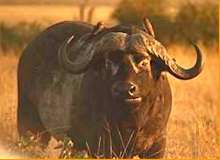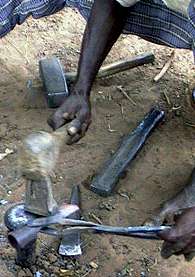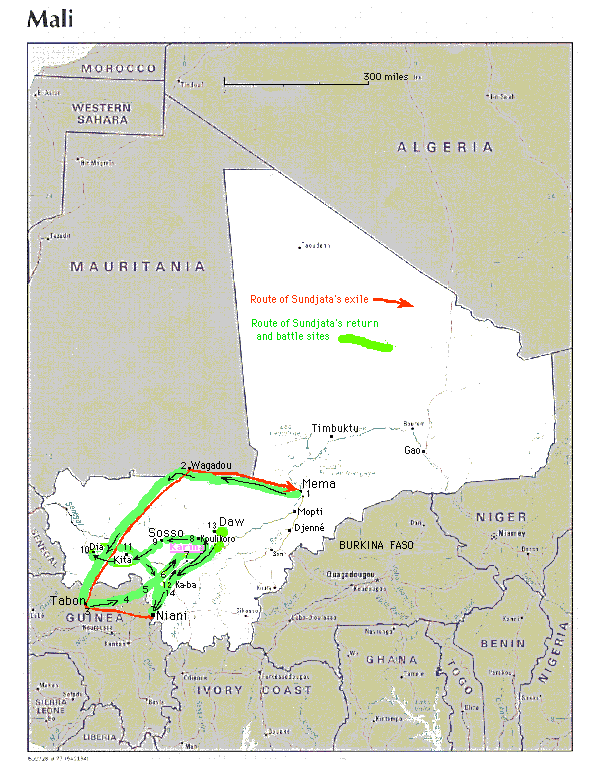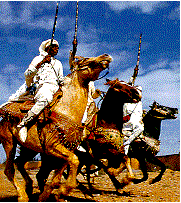

King Nare Maghan Kon Fatta learns that if he marries Sogolon Kedju, their son will become a great ruler. In time, he meets and marries her, and she becomes pregnant with his child. Sasuma Berete, Nare Maghan's first wife, then curses Sogolon.
After a long pregnancy, Sogolon Kedju gives birth to Sunjata, who is lame.
King Maghan dies, and Dankarantuma becomes king of Manding. Sunjata finally
walks. Fram Kamara and Kamandjan become his friends.
Sunjata kills the beast that is ravaging Niani and becomes a hero.
Sasuma fears Sunjata and unsuccessfully plots his death. Sogolon then decides
to take her family into what will become a seven-year exile. They travel first
to Djedeba and then to Tabon and Wagadu. Finally, they arrive in Mema, where
they remain.
Meanwhile, Sumanguru Kante has his way in the western kingdoms, and both Balla
Fasseke and Nana Triban prepare to help Sunjata conquer the sorcerer-king.
Sunjata leaves Mema to become king of Manding. His journey takes him to Wagadu
and then to Tabon, the site of the first battle against Sumanguru. Sunjata's
victory brings Balla Fasseke and Nana Triban to join the armies at Sibi.
The armies under Sunjata's command move to Krina, where Sunjata and Sumanguru
Kante declare war. Fakoli Koroma joins Sunjata, and together they defeat Sumanguru.
Sunjata's forces then destroy Sosso, making their victory complete.
Sunjata expands Manding into the empire of Mali and becomes its emperor. He then returns to Niani, where he reigns in peace as the king of kings.

The purpose of this myth was both mystical and pedagogical.
Mystical- is dealing with magic and spells and powers.
Pedagogical-teaches you how to live.
The entire myth is surrounded by mystical powers such as spells, curses, magic etc. here are a few examples:
As on page 423 it shows that the witches egg worked its magic and stopped the buffalo from charging at him by turning the ground into mud.
Also on page 423-king Maghan's jealous first wife gets angry and curses Sogolon to have a long pregnancy, and she does not have Sunjata until after king Maghan dies.
The main purpose of this myth is to teach people how to live life in the mindset of Sunjata who was peaceful and kind to everyone. And he believed everyone were equals. Sunjata was perceived as a hero to the people and he is used as a role model to lead the way into dealing with problems from life. Some examples are found:
On page 432, old ladies are testing him by stealing vegetables from his garden at night, and as they run away he says, "welcome, old folk...You have no need to run away! Our garden supplies all who need its vegetables. Come and I myself will fill your calabashes. And remember to return whenever you need what we grow here."
In chapter 8 Sunjata gains respect and peace from all the surrounding cities,
and he reigned in peace as king of kings.


Mandingo is the name of a group of West Africans that are descendants of the founders of the powerful Mali Empire. The Mande-speaking people have so many different dialects they sometimes cannot understand one another. The Mali Empire flourished from 1240-1500 and its leaders eventually converted to Islam, but the Mandingo people did not. Sunjata occurred between 1217 and 1237.
Today many of the Mandingo people still practice traditional African religions.
Their main careers are farmers, herders, traders, and artists. The Mande society
was composed of many social castes. At the top were nobles, beneath them were
professional people, and at the bottom were slaves. Oral tradition was also
quite popular for this culture. The griots sang songs that immortalized the
royal families honor and glory rather that their undesirable traits.
A lot of their artwork is made of gold or painted golden. The game of Mangala
was popular as well, people would make bets just as in the myth Sunjata was
challenged to a game of Mangala to determine if he should die or not. Sunjata
reveals the values of his society by his heroic code. Sunjata has a bad youth,
performs magical feats, goes through a period of exile, kills a monster, protects
his community, is a warrior, and becomes a great king and ruler of a mighty
kingdom.

An archetype is an original model on which something is patterned. In other
words, an archetype is a certain "character" or "theme"
that is popular in many movies and stories. The most common example of an archetype
would be a hero, we find heroes in almost every movie or story we read. It's
basically a pattern that repeats itself and is found everywhere. It even happens
in real life. Some more examples of archetypes are damsel in distress, companion,
guide, good vs. evil, serpent, creation, etc.
Some archetypes used in the myth Sunjata were Hero, Companion, Haven, and Good
vs. Evil.
Sunjata was seen as a Hero to his people in chapter 3 after defeating the beast that was ravaging Niani. Also in the end he saves Manding from Sumanguru and is seen as a hero and savior to the manding kingdom that he rules from then on.
Sunjata's Haven was in Mema, where he grew up and was save from harm. (Chapter 4) He also learned all his great wisdom and courage from the king there. It was a place he could call home forever.
Throughout the whole story there is a battle of good vs. evil going on. In the beginning there is automatically a "good" force put on Sunjata. Along the path of his life there are evil forces he must defeat such as Sasuma cursing him, Sasuma's son, Dankarantuma, beasts, and Sumanguru. Of course, him being the hero, he defeats all of them and lives happily ever after. Yet another archetype theme.


The "journey of a hero" is quite a popular theme in mythology and also many stories and movies you are familiar with. It's basically the path that which the hero was destined to take. There are many stages in the journey of a hero, as I will discuss with you only a few stages out of many our hero Sunjata goes through.
One stage Sunjata goes through would be "the call". When Sunjata realizes that he must stand and walk for everyone's sake and he decides to do it by himself. He then realizes he is capable of walking. He has been called upon to do more things than crawl and he has excepted that.
Another stage would be "the abyss" and "the transformation". When Dankarantuma took his best friend from him and left him alone and companionless to face the world by himself. Then he goes on and finds out that he is better than that and can defeat evil even without his good companion there to help him.
A third stage is "road of trials". The very last battle between Sumanguru
and Sunjata which ends what he has been fighting for his whole life that then
leads to another stage "freedom to live". Sunjata can live in peace
and rule over Manding.
Sparks, Kay. "The Hero's Journey." Online. January 1998. Available.
http://hubcap.clemson.edu/~sparks/sffilm/mmswtab.html
Peterson, Nick. "Peoples and cultures of Africa." Online. Web group
1999. Available.
http://www.fandm.edu/departments/Anthropology/Bastian/ANT269/man.html
Rosenberg, Donna. World Mythology. Illinois:NTC Publishing Group, 1994.
"Fetzer, Scott." The World Book Encyclopedia. 1989, 137.
www.askjeeves.com
www.yahoo.com
www.google.com